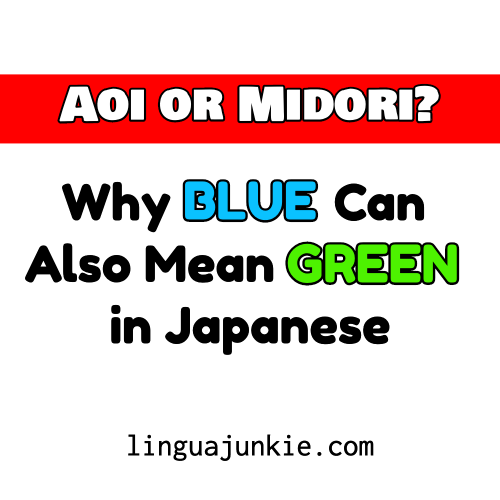You might’ve come across a phrase like “Ao Shingou” in Japanese and got confused.
“Ao Shingou” literally means blue light — the phrase for the traffic light in Japan…
…and it’s most definitely green, not blue. So what’s the deal?

Is there a blue-green distinction in Japanese? Let’s find out.
| Want a bundle of 30+ Japanese PDF Lessons? These colorful and printable PDFs teach you Japanese phrases… and they’re free for new learners. Click here to get Japanese PDF Lessons.  |
Are “Ao” and “Midori” Both Blue in Japanese?
- Blue: 青
- Hiragana: あお
- Reading: ao
- Green: 緑
- Hiragana: みどり
- Reading: midori
For us in the West, blue and green are completely separate colors…
With Japanese, blue and green can indeed mean the same color… which can make it confusing for learners.
Why?
Throughout Japanese tradition and history, colors have been fluid and ambiguous.
Colors wore more seen as “groups” just like most of us would agree that pink and purple would be in one group because they’re quite close.
Well, that’s how it worked.
Since Japan was influenced by China, the Chinese character 青 was used to refer to cool colors like the blues, greens and greys.
And so, it was a bit ambiguous. They could see the distinctions but the name was the same.
Plus, since the 600’s in Japan, color has played an important role in determining social hierarchy and class.
For example, certain colors were forbidden and reserved only for the imperial family.
This way, Japan has always placed a significance on colors with a symbolic meaning attached to them.
The word for blue is “ao” (青) and it is translated into English as “blue”.
Most of the time “ao” means blue but in very specific situations it can also symbolize the color green. (see reasons above.)
This happens in contexts such as traffic lights.
Japanese people say “blue” instead of “green” for traffic lights even though the light is clearly green.
Blue also has a special meaning in Japanese because it is used to mean “youth” and “adolescence”.
Now, the word for green is “midori” (緑) in Japanese.
This word actually came into existence about much later (Heian period), so for a while, it was “ao” strutting around and serving the dual purpose of representing blue and green.
The unique part about “midori” is that there is never ambiguity about whether it is blue or green.
“Midori” always means green whenever you use it.
Examples of “Ao” Being Used as Green
The best way to learn when “ao” means green is through specific examples.
You might notice that many of the instances when “ao” is used for green are for colors occurring in nature like leaves, seaweed, apples, and bugs.
Here are some common situations where “ao” is green:
1. 青信号
- Ao Shingou
- Green Light
One of the most interesting situations when you’ll notice the word “ao” used for green is for traffic lights.
In English, we tend to think that green is “go” and red is “stop”. For Japanese people, it is “ao” for green light instead.
2. 青虫
- Ao mushi
- Cabbageworm
The cabbageworm is a green caterpillar that grows into a white butterfly. In Japanese, the word for this is “ao mushi” which translates into “blue bug”. “Ao” is used in this context as the word green.
3. 青汁
- Ao jiru
- Green juice
Green juice in Japanese is called “ao jiru” and it is a popular health supplement for Japanese people. The juice is made from kale or barley grass. If it was translated directly into English it would be “blue juice”.
4. 青葉
- Ao ba
- Fresh green leaves
Fresh leaves are called “ao ba” in Japanese. One of the reasons for this could be that “ao” also means “young”. Since these leaves are still young and fresh, they prefer to use “ao” over “midori”.
5. 青リンゴ
- Ao ringo
- Green apples
Another interesting example of “ao” being used is with apples. Green apples are known as “ao ringo” which would translate into English as blue apples!
6. 青のり
- Ao nori
- Green laver (seaweed)
The seaweed that is put on top of many popular Japanese dishes is called “ao nori”. It can be found on top of okonomiyaki (Japanese pancakes) and yakisoba (Japanese street noodles).
How Should a Learner Approach This?
This whole blue-green ambiguity can be extremely confusing for a Japanese learner.
Although a Japanese person would still understand what you mean, it would show a deep understanding of the language if you can use these words in the correct situations.
Here are some methods for mastering “ao” and “midori” and figuring out how to use them:
Learn through examples
You can learn when to use “midori” compared to “ao” through examples.
The word “ao” is only used for green in specific cases.
In all other situations, you can say “ao” as a default for blue.
If you can learn those specific instances and memorize them, you should be able to know when to use each one.
Observe native speakers
The other way to learn these two colors is to observe native speakers.
You’ll slowly notice when someone says “ao” compared to “midori” and can see some patterns.
For example, if people always say “blue” for green light, you’ll start to notice that it is the normal pattern in Japanese.
Read and listen to Japanese
Another great way to learn is by reading Japanese through books or newspapers. It’s also just as beneficial to watch movies and videos in Japanese.
This can show examples of how the language is being used. Just like observing native speakers, you’ll gradually see when one word is used over another.
Practice with native speakers
The best way to learn which word to use is to practice with native speakers. This way,
you can also ask specific questions about this difference. It could be interesting to ask Japanese people why they think that blue can sometimes mean green.
By understanding how a Japanese person thinks when speaking, it could become easier to master “ao” and “midori” in Japanese!
– The Main Linguajunkie
P.S. Interested in learning Japanese? This Japanese course for Absolute Beginners from JapanesePod101 is FREE for a limited time only. They plan to close it down in the future, but while it’s still open, give it a try. Click the image below.
